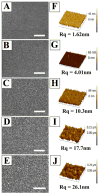Tunable nanostructured conducting polymers for neural interface applications
- PMID: 29060258
- PMCID: PMC5805560
- DOI: 10.1109/EMBC.2017.8037214
Tunable nanostructured conducting polymers for neural interface applications
Abstract
Advancement in the development of traditional metallic-based implantable electrodes for neural interfacing has reached a plateau in recent years in terms of their ability to provide safe, long-term, and high resolution stimulation and/or recording. The reduction of electrode size enables higher selectivity through increased electrodes per implant device; however, it also results in lower sensitivity at electrode-tissue interfaces. This limitation can be addressed through the utilization of conducting polymer (CP) coatings, which increase the effective surface area. In this work, we investigate the surface roughness of two common conducting polymers; poly(pyrrole) (PPy) and poly(3,4-ethylenedioxythiophene) (PEDOT) in the form of films deposited using both potentiostatic (PSTAT) and galvanostatic (GSTAT) methods. We found that the surface roughness of both CP films can be increased by over 90% through control of both deposition time and applied electrical deposition (current for GSTAT and voltage for PSTAT). The impedance of PPy-modified electrodes was found to decrease by up to 88%. This study shows that the surface roughness of CPs can be modulated to control electrical properties of neural electrodes and may improve the cellular response of neurons.
Figures



References
-
- Nicolelis MAL. Brain-machine interfaces to restore motor function and probe neural circuits. Nature Rev Neurosci. 2003 May;4:417–422. - PubMed
-
- Buzsaki G. Large-scale recording of neuronal ensembles. Nat Neurosci. 2004 May;7:446–451. - PubMed
-
- Wallace GG, Spinks GM. Conducting polymers - A bridge across the bionic interface. Chem Eng Prog. 2007 Dec;103:S18–S24.
MeSH terms
Substances
Grants and funding
LinkOut - more resources
Full Text Sources
Other Literature Sources
Miscellaneous
